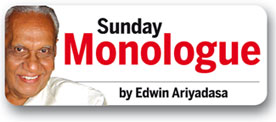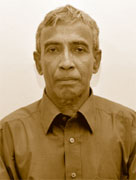Voices from the past

"How can we live without our lives?
How 'will we', know it's us without our past?"
(-John Steinbeck 1902-1968)
A cute young lady was asked about the profession of the person she
would like to marry.
Pat came her answer:
"Archaeologist."
"And why?"
"The older I grow the stronger will be his love for me."
In the present essay my focus, is a member of this tribe-an
archaeologist. In Sri Lanka, we inhabit a land, with a history, that
extends to the far past. Besides, we are growing still older with each
passing second.
Given such a context, archaeologists will love us with an ardour,
that grows stronger with each second that passes. An eminent indigenous
archaeologist of Sri Lanka, who had a life-long love-affair with the
island's past, was Prof. Senerat Paranavithana. His dedication to the
profession was self-less.
His scholarship was legendary. His interpretations of ancient records
and objects, were nothing short of the miraculous. He was a complete
archaeologist, who possessed an unparalleled gift to reveal what was
hidden within material that came under his archaeological scrutiny.
 |
|
Sirisaman Wijetunga |
Many grew up under his shadow.
Lithic records
Sirisaman Wijetunga, ex-Assistant Director of Archaeology and former
Media Consultant to the Central Cultural Fund, is one of those, who came
under the sway of Prof. Senerat Paranavithana's iconic presence.
His publication, titled 'Communications Aspect of Sri Lanka's Lithic
Records," is a thorough research effort.
The main thrust of his research is to establish the crucial role
played by lithic records in Sri Lanka, as a medium of public
communication.
Although that is the central concern of writer Sirisaman Wijetunga,
he has transformed his work into a sustained thesis, that traces the
origin and evolution of Sri Lanka's lithic records.
The tradition of setting up lithic records in Sri Lanka, goes as far
back as the 3rd century BC. The cave inscriptions of that era, record
the granting of those shelters to the monks for their meditations, by
dedicated devotees. The brief text of the inscription was followed,
generally, by the name of the donor.
Cave inscriptions
Sirisaman Wijetunga is of the view, that the purpose of those cave
inscriptions, was merely to communicate to the people that a given
devotee has made a grant. As the simple cave dwelling evolved eventually
into elaborate monastic complexes, the lithic records reflected this
development.
The routines, duties, obligations, rites and rituals, maintenance,
etc., had to be set down in detail. With the passage of time, the
communications aspects of the lithic records, turned out to be more
complex, as those inscriptions took the guise of Royal Decrees.
Sirisaman Wijetunge notes that, the lithic records, communicate at
two levels - directly and obliquely. In the direct communication mode,
these records convey a specific content to the people. In the process of
oblique communication, the location of the records, matters to a great
extent. The changing locations trace the spread of settlements,
colonies, townships and even minor fiefdoms. This way, the places where
the records are located enable the tracing of cultural diffusion. Pillar
inscriptions
The author lays special stress on the type of pillar inscription,
described as "Grant-pillars." These pillar inscriptions record royal
grants to monasteries. When such authoritative Grant-Pillar inscriptions
are established, those monastic institutions will not be troubled by
those who might want to interfere in their maintenance.
In some instances, the decrees in the Grant-Pillar inscriptions were
further reinforced by figures of crows and dogs, implying that those who
go counter to the provisions in the inscriptions, will be reborn as
crows and dogs.
According to Sirisaman Wijetunga, every possible effort was made to
see that these inscriptions functioned unambiguously as authoritative
forms of communication. Sirisaman Wijetunga's work, possesses an
important social implication for our time. This work enables even the
ordinary reader to appreciate how sacred our lithic records are. This
high deference towards the material from our past in quite essential to
prevent vandalism, and the destruction of precious archaeological
material through misunderstanding.
Archaeological treasures
Beneath the surface of our land, we have a tremendous hoard of
archaeological treasures. In the course of building structure or the
clearing of land, someone may inadvertently destroy some precious
archaeological material.
A popular awareness of archaeology will go a long way, in building a
responsible attitude towards our past. Writer Sirisaman Wijetunga's
present work, is the prototype of popular but responsible book, that can
enhance public deference for archaeology. Finds by archaeologists
establish our cultural and national identity. As John Steinbeck said:
"How will we know it's us, without our past?"
Sirisaman Wijetunga's work, is the outcome of prolonged, sustained
and assiduous effort. If he continues to reveal the absorbing aspects of
archaeology, in a series of works produced for general consumption, it
will undoubtedly prove a wholesome national service.
|

